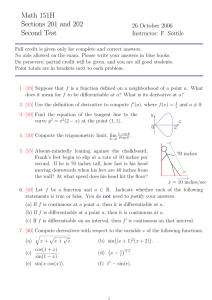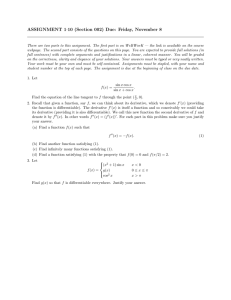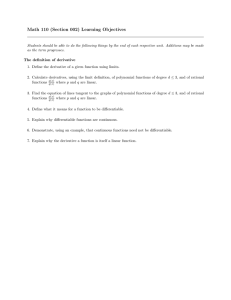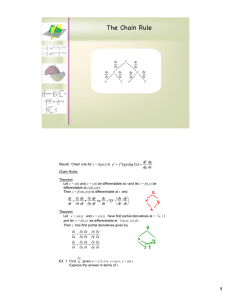Document 11722859
advertisement
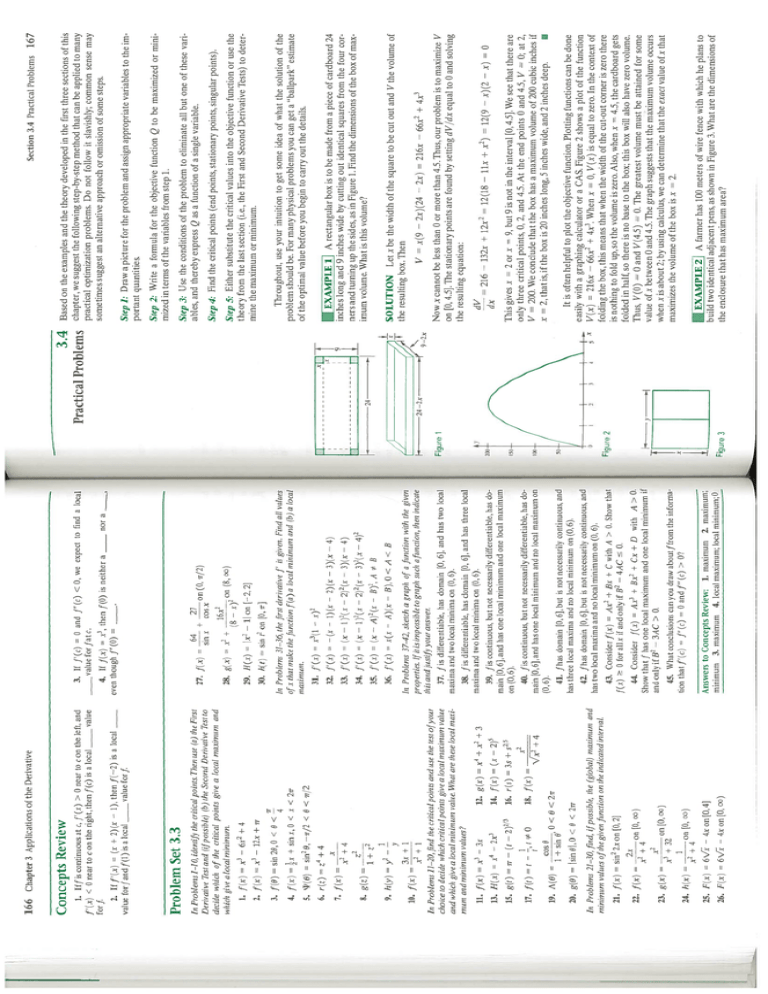
= 5. ‘(&) g(z) = = — — 4 2 y 1 x 4 — 2 z +4 + 2 ± < 9,—7r/2 2 sin 4 z < 0 < -I- sins, 0 < 12x ± v 2 6r sin 20,0 3 x 4 x < 2w g(t) = — (t — 3 4 — 2x x IT = 2)2/3 = 20. g(0) IsinOI,0 <9 < 2n- cos 0 O<t9<2r 1 -f sin 0’ 18. f(x) 14. X - f(x) = (x 16. r(s) = 3s +- 2 s 2) 3 -x 2 4 12.g(x)=x + f(x) g(x) 22. 23. 26. F(x) 25. F(x) 24. h(x) f(x) 21. = = = = + + X -f 2x 6\/ x x — — 4 on [0,00) [0, oo) 4x on [0, 00) 4x on [0,4] on [0, co) 32 4 2 2x on [0, 2] sin in Problems 21—30, find, if possible, the (global) mnaxinnun and ndnirnuni values of the given flnction on the indicated interval. = 19. A(0) t0 1 17. f(t)=t — , 15. 13. H(x) 3x 11.f(x)=x — 3 5, 3x + 1 10. f(x) = x- + 1 Jn Problemns 11—20, fInd the critical points and use the test of your choice to decide which critical points give a local irmaxini urn value and which give a local mninimwn vahie. What are these local mnaxi mum and niinimnum values? 9. h(y) 8. 7.f(x)= = = 4. f(.r) 6. r(z) = = 3. f(9) 2. f(x) 1. f(.r) In Problems 1—10, identify the critical points. Then use (a) the First Derivative Test and (ifpossible) (6) the Second Derivative Test to decide which of the critical points give a local niaxirnuni and which give a local nminiirmurn. Problem Set 3.3 1. Iffis continuous at c, f’(x) > 0 near to con the left. and value f’(.x) < 0 near to c on the right, then f(c) is a local forf 2. If f’(x) = (x + 2)(x 1), then f(—2) is a local value for f. value forf and f(l) is a local — Chapter 3 Applications of the Derivative Concepts Review 166 on (8,oo) 1 on [—2,21 — sin t2 on [0, w] — (8 2 16x —on(0. r/2) cosx nor a = — — — — , A 2 B) 2)2(5 B r 3) ( 2 — 4)2 A)(.r— B).0<A< B r 4) ( 2 1 )2( - — — x(x (x (x (x — 1)2(x - 2)2(x - 3)(x -4) -(x - l)(x - 2)(z - 3)(x -4) (1 3 x minimum 3. maximum 1. maximum 2. maximum; 4. local maximum; local minimum;0 Answers to Concepts Review: — 37. f is differentiable, has domain [0. 61, and has two local maxima and two local minima on (0, 6). 38. f is differentiable, has domain [0, 6], and has three local maxima and two local minima on (0, 6). 39. f is continuous, but not necessarily differentiable, has do main [0,6], and has one local minimnuni and one local maximum on (0,6). 40. f is continuous, but not necessarily differentiable, has do main [0,6], and has one local minimum and no local maximum on (0,6). 41. f has domain [0,6], but is not necessarily continuous, and has three local maxima and no local minimum on (0,6). 42. f has domain [0,6], but is not necessarily continuous, and has two local maxima and no local minimum on (0, 6). 43. Consider f(x) = Ax 2 -I- Bx + C with A > 0. Show that f(s) 0 forallx if andonlyifB 2 — 4AC 0. 2 + Cx ± D with A > 0. 44. Consider f(s) = Ax 3 -t- Bx Show that f has one local maxirnllm and one local minimum if 2 3AC > 0. and only if B 45. What conclusions can you draw aboutffrom the informa tion thatf’(c) = f”(c) = 0 andf”(c) > 0? In Problems 37—42, sketch a graph of a function with the given properties. If it is impossible to graph such afunction, then indicate this and justify your answer 36. f(s) = = 34. f(s) 35. f(s) = = = 33. f’(x) 32. f’(x) 31. f(s) f’ is given. Find all values of x that make the function f(a) a local minimum and (b) a local maxilnuni. = 2 + x slnx —--—- ± 27 In Problems 31—36, the first derivative 30. h(t) = = g(x) 28. 29. B(s) = f(x) 27. 64 4. If 1(x) = x , then f(0) is neither a 3 even though f”(O) = 3. If f’(c) 0 and f”(c) <0, we expect to find a local value for fat c. r Figure 3 24—2x 24 IE 1 Figure 2 Figure 1 I_____ + ± r xt I 9—2x 3.4 Practical Problems 167 Q to be maximized or mini = x(9 — 2x)(24 — 2x) = 216x — 2 + 4x 66x 3 216 — 132x + 12x 2 12(18 — ) 2 lix + x = 12(9 — x)(2 — x) = 0 iiiLE} A farmer has 100 meters of wire fence with which he plans to build two identical adjacent pens, as shown in Figure 3. What are the dimensions of the enclosure that has maximum area? It is often helpful to plot the objective function. Plotting functions can be done easily with a graphing calculator or a CAS. Figure 2 shows a plot of the function V(x) = 216x — 66x 2 + 4x . When x = 0, V(x) is equal to zero. In the context of 3 folding the box, this means that when the width of the cut-out corner is zero there is nothing to fold up, so the volume is zero. Also, when x = 4.5, the cardboard gets folded in half, so there is no base to the box; this box will also have zero volume. Thus, V(0) 0 and V(4.5) 0. The greatest volume must be attained for some value of x between 0 and 4.5. The graph suggests that the maximum volume occurs when xis about 2; by using calculus, we can determine that the exact value of x that maximizes the volume of the box is x 2. This gives x = 2 or x = 9, but 9 is not in the interval [0, 4.5].We see that there are only three critical points, 0, 2, and 4.5. At the end points 0 and 4.5, V 0; at 2, V = 200. We conclude that the box has a maximum volume of 200 cubic inches if x = 2, that is, if the box is 20 inches long, 5 inches wide, and 2 inches deep. I = Now x cannot be less than 0 or more than 4.5. Thus, our problem is to maximize V on [0, 4.5]. The stationary points are found by setting dV/dx equal to 0 and solving the resulting equation: V SOlUTION Let x be the width of the square to be cut out and V the volume of the resulting box. Then A rectangular box is to be made from a piece of cardboard 24 inches long and 9 inches wide by cutting out identical squares from the four cor ners and turning up the sides, as in Figure 1. Find the dimensions of the box of max iniumn volume. What is this volume? Throughout, use your intuition to get some idea of what the solution of the problem should be. For many physical problems you can get a “ballpark” estimate of the optimal value before you begin to carry out the details. Step 5: Either substitute the critical values into the objective function or use the theory from the last section (i.e., the First and Second Derivative Tests) to deter mine the maximum or minimum. Step 4: Find the critical points (end points, stationary points, singular points). Step 3: Use the conditions of the problem to eliminate all but one of these vari ables, and thereby express Q as a function of a single variable. Step 2: Write a formula for the objective function mized in terms of the variables from step 1. Step 1: Draw a picture for the problem and assign appropriate variables to the im portant quantities. Based on the examples and the theory developed in the first three sections of this chapter, we suggest the following step-by-step method that can be applied to many practical optimization problems. Do not follow it slavishly; common sense may sometimes suggest an alternative approach or omission of some steps. Section 3.4 Practical Problems

